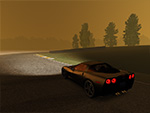
| Home | Bend the objects. |

|
|
|
Introduction
This page is a reference to animation functionality in Tracked. A tutorial describing how to add a dancing guy to Carlswood can be found here.
Movables/animatables in Tracked
Let’s briefly go over the tabs:
The movables are stored in geometry.ini alongside the static geometry, and saved when you save whole the track (with the 'Save track' button, or by pressing Shift-S).
The Group tab
A group is a collection of movables. When you want a selection of movables to do the same thing, you put them in the same group and address the group.
There is one group by default, you can add a group by clicking the 'Add' button.
The Creation tab
Here, you can load dof’s and give them a position and rotation on your track.
Load a dof by clicking the “Load dof” button, browse to your track folder and select the desired dof to load.
Note that you can only load a dof when it’s in your track folder.
When you have placed a mesh on the track and added physics, joints, … you can save the settings of that particular dof by clocking the “save settings for active dof” button. This can be useful, for cones, for example.
By clicking the “View anim’s” button, you can see the names of any possible animations stored in the accompanied .’anim’ file.
By clicking the 'Create' button, you can create an instance of the dof on the track, on the position of your spline-point. When you have presets saved for the created dof, they will be loaded automatically.
You can edit the position and rotation with the sliders if needed.
The physics tab
Meshes with collision shapes are a great way to bring some more dynamics in Racer. Here, you can add a collision shape to a mesh and edit the collision body.
When the mesh has bones, you can click on the “Bonephysics” check button and edit the collision body’s per bone.
Click on the “Create col. Shape” button if you want to create the collision shape.
If you remove a collision shape, you also remove each joint linked to that physics body, so be carefull.
Shape: This spinner controls the shape of the physics body, primitives are more performance friendly.
Size: Control the size of the physics body.
Offset: You can offset the physics body from the mesh. Note that the center of gravity will still be in the center of the mesh.
Rot: Control the rotation relative to the mesh.
Inertia: Body inertia.
Weight: Weight in kg.
Freeze Initially: A frozen body can hang in midair, and will be unfrozen when a force acts upon the body.
Every physics body is frozen by default for performance reasons.
The joint tab
A joint is a way to connect two collision body’s. Think of a hose that has 5 bones, every bone has its own physics body, and those physics body are connected by a joint, with the pivot points in between the collision bodys.
if you want to add a joint to a collision body, select the desired parent from the list. You can also have the world as parent.
The pivot point can be controlled by the spinners.
The Bone anim. tab
By clicking the check button, you enable the animations that are linked to the bones in the mesh for use in Racer.
Movables console commands
The movables can be controlled in Racer by sending commands via console.
The commands must begin with ‘anicmd’.
Available general commands:
- ‘reset’: reset’s all the movables to their initial state
Available bone animated commands:
- ‘play <sequence>’ : play an animation (v0.8.9.2+)
- ‘playloop <sequence>’ : loop an animation (v0.8.9.2+)
- ‘stop’ : stops an animation
The reset command does not need a group number, it’s optional.
These commands can be used in triggerlines or scripts.
Triggerlines
Triggerlines are a way to trigger console commands when a car passes that trigger. You can create a trigger the same way you create a timeline. Make a spline, and click the “Declare triggerline” button in the “Positions” tab. Then enter the console command that the triggerline should use when triggered.
Object mode
This alternative way of moving around in tracked’s 3D space is very useful when editing movables for example.
Press ‘O’ or click on the checkbox in the bottomleft corner. Now you can navigate around a virtual point in 3D space. Press the ‘E’ button to do a ‘zoom extents’ on a object.
You can zoom use the scrollwheel to zoom. Move around by using the default combinations of buttons used in default navigation mode. Hold the ctrl button for smaller movements.
(last updated November 13, 2012 )